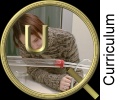|
Approach
Discuss gases, particulate matter and pollutants in the air we are exposed to. Speak about how these compounds reach us.
Integration of the material in this edition:
This edition tells in its part A in particular about two foci of atmospheric research: a) immissions b) transport.
a) Immissions are defined as the impact of pollutants (also noise and radiation) on humans and the environment. The negative influence of immissions is often stronger in an urban environment. Therefore, it is good to speak about such influences in the context of "life in an urban environment" or "urbanisation" or "town and country planning".
b) The transport of air masses (and trajectories) strongly depends on meteorological factors. Therefore, the topic can also be discussed in the context of "wind and weather". Meteorology does not only determine precipitation and temperature, but also the distribution of emissions.
Unit for 2-4 lessons
Step 1: (preparatory homework) Ask the pupils to collect coins for about 3-4 weeks, until about 100 coins are gathered.
Step 2: (classes) Read together with the pupils the first text (coffee in the wind) and the corresponding questions (activity A1). If computer work is possible, ask the pupils to localise housing areas and industrial as business zones in their own town in Google Earth.
[This step can also be used in the context of lessons on "town planning".]
Step 3: (classes) Discuss in the lesson different ways of distribution and by which means they are determined (goods - streets, railway lines; money - banks; compounds in the air - wind direction and speed). Introduce the technical term "trajectory".
Step 4: (homework) Distribute the worksheets on money tracking and ask the pupils to allot the collected coins. From random samples of some pupils you may develop a class overview. Which countries dominate? Why?
Step 5: (classes) Read the research texts "pathways of air" and kerbside measurements" in a computer room (or with a projector and single internet connection).
Step 6: (classes) Give an impression of the floating properties of particles to the pupils. For this you may carry out the flour powder experiment.
Step 7: (classes) If possible, speak about particle measurements in your town and visit an air quality station in your neighbourhood.
Objectives
The pupils shall recognize that air is a carrier of trace gases and particles, which can be smelled and seen (natural and artificial scents, exhaust gases, dust, particulate combustion products).
They shall become aware that compounds carried by the air have an influence on our health due to inhalation.
The pupils shall understand that there are diverse sources for the compounds in our environment: close and far, natural and human made.
They shall recognize that the transport ways depend on external conditions (on meteorology) and that we can only influence some sources of air pollution in our neighbourhood.
The pupils shall understand that the consequences (e.g. political measures, limit values for particulate matter) are tools for the protection of the population, but they are based on a very simple and incomplete idea of air pollution.
Methodology
The story of Katja and Claus is the story of a schoolgirl who sees herself exposed to certain influences from her enviroment and asks about their origin. The pupils are invited to fill the role of Katja, to observe their own environment and to get to the bottom of environmental influences around them.
We experience different odours in a town, at the countryside, in nature. We also experience that the air is sometimes clear, sometimes opaque or "dirty". This edition analyses such phenomenon in three levels of learning.
1) Perception and experience: Which properties has the air around us?
2) Analysis of origin and ways: Which ways do things go?
3) Consequences and conclusions: Can we react to external impacts?
|
 > ACCENT en > UQ 2 Mar 07 Urban air > C: Information for teachers > Classes Part A
> ACCENT en > UQ 2 Mar 07 Urban air > C: Information for teachers > Classes Part A